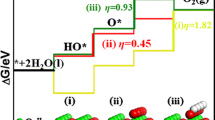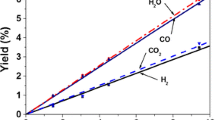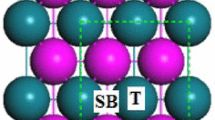Abstract
Hydrogen peroxide (H2O2) is a highly effective, green oxidant that has been widely used in many chemical industries. Two coverage-dependent models are built in micro-kinetic study and successfully applied to investigate the direct H2O2 synthesis mechanism from hydrogen and oxygen on Pd(111) surface. The computational results from both models show that the selectivity to H2O2 can reach 99%, which takes advantage of the repulsion effects between the adsorbates and O* on the surface. H2O2 comes from the sequential hydrogenation of O2 and H2O as the by-product is dominantly from H2O2* decomposition. Therefore, how to inhibit H2O2* decomposition is the key step to achieve high selectivity on Pd(111) surface. Both models show H2O generation with higher apparent activation energy compared to H2O2 formation, indicating that low temperature will benefit selectivity to H2O2. The calculated apparent activation energies are 22.30 kJ mol−1 for H2O2 formation and 48.67 kJ mol−1 for H2O generation by the standard method, which agrees well with the experimental observations. It indicates that the coverage-dependent micro-kinetic study is a feasible method to investigate reaction mechanisms on various surfaces.



Similar content being viewed by others
References
Lewis RJ, Hutchings GJ (2019) ChemCatChem 11(1):298
Biasi P, Serna JG, Salmi TO, Mikkola JP (2013) Chem Eng Trans 32:673
Ranganathan S, Sieber V (2018) Catalysts 8(9):379
Staykov A, Kamachi T, Ishihara T, Yoshizawa K (2008) J Phys Chem C 112(49):19501
Tian PF, Ouyang LK, Xu XC, Xu J, Han YF (2013) Chin J Catal 34(5):1002
Deguchi T, Iwamoto M (2013) J Phys Chem C 117(36):18540
Tian PF, Ding DD, Sun Y, Xuan FZ, Xu XY, Xu J, Han YF (2019) J Catal 369:95
Song X, Sun KJ, Hao XF, Su HY, Ma XF, Xu YH (2019) J Phys Chem C 123(43):26324
Jorgensen M, Gronbeck H (2016) ACS Catal 6(10):6730
Guo W, Vlachos DG (2013) J Chem Phys 138(17):174702
Getman RB, Schneider WF (2010) ChemCatChem 2(11):1450
Wang YG, Cantu DC, Lee MS, Li J, Glezakou VA, Rousseau R (2016) J Am Chem Soc 138(33):10467
Sabbe MK, Canduela-Rodriguez G, Joly JF, Reyniers MF, Marin GB (2017) Catal Sci Technol 7(22):5267
Bajpai A, Frey K, Schneider WF (2020) Langmuir 36(1):465
Grabow LC, Hvolbaek B, Norskov JK (2010) Top Catal 53(5–6):298
Kresse G, Hafner J (1993) Phys Rev B Condens Matter 48(17):13115
Perdew JP, Burke K, Ernzerhof M (1996) Phys Rev Lett 77(18):3865
Blochi PE (1994) Phys Rev B Condens Matter 50(24):17953
Kresse G, Joubert D (1999) Phys Rev B 59(3):1758
Li J, Ishihara T, Yoshizawa K (2011) J Phys Chem C 115(51):25359
Eichler A, Mittendorfer F, Hafner J (2000) Phys Rev B 62(7):4744
Sun K, Zhao Y, Su HY, Li WX (2012) Theor Chem Acc 131(2):1118
Norskov JK, Rossmeisl J, Logadottir A, Lindqvist L, Kitchin JR, Bligaard T, Jonsson H (2004) J Phys Chem B 108(46):17886
Coenen K, Gallucci F, Hensen E, Annaland MV (2019) Chem Eng J 355:520
Chen L, Smith RS, Kay BD, Dohnalek Z (2016) Surf Sci 650:83
Sun KJ, Su HY, Li WX (2018) Theor Chem Acc 137(10):128
Evans AG, Polanyi M (1938) Trans Faraday Soc 34:11
Prestianni A, Ferrante F, Duca D (2017) Theor Chem Acc 136(1):6
Fantauzzi D, Zhu TW, Mueller JE, Filot IAW, Hensen EJM, Jacob T (2015) Catal Lett 145(1):451
Cvetanović RJ, Amenomiya Y (1967) Application of a temperature-programmed desorption technique to catalyst studies. In: Eley DD, Pines H, Weisz PB (eds) Advances in catalysis, vol 17. Academic Press, Cambridge, p 103
Carsten S, Anders A, Campbell CT (2009) J Am Chem Soc 131(23):8077
Manatt SL, Manatt MRR (2004) Chem Eur J 10(24):6540
Abate S, Centi G, Perathoner S, Melada S, Pinna F, Strukul G (2006) Top Catal 38(1–3):181
Voloshin Y, Halder R, Lawal A (2007) Catal Today 125(1–2):40
Gemo N, Biasi P, Canu P, Salmi TO (2012) Chem Eng J 207:539
Acknowledgements
We are grateful for financial supports from the Natural Science Foundation of Hebei Province (No. B2017203113, B2016203158) and the National Natural Science Foundation of China (No. 21872136).
Author information
Authors and Affiliations
Corresponding author
Additional information
Publisher's Note
Springer Nature remains neutral with regard to jurisdictional claims in published maps and institutional affiliations.
Rights and permissions
About this article
Cite this article
Sun, K., Song, X., Hao, X. et al. Application of coverage-dependent micro-kinetic study to investigate direct H2O2 synthesis mechanism on Pd(111) surface. Theor Chem Acc 139, 170 (2020). https://doi.org/10.1007/s00214-020-02676-y
Received:
Accepted:
Published:
DOI: https://doi.org/10.1007/s00214-020-02676-y




